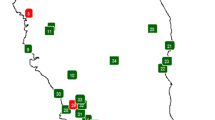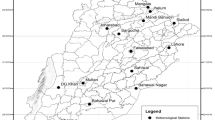Abstract
Hierarchical spatio-temporal autoregressive models are useful to understand the impact of predictors on a spatio-temporal-dependent variable. This study aims to fit the model to monthly PM10 concentration using potential predictors from 33 monitoring stations within Peninsular Malaysia from 2006 to 2015 and predict the space–time data spatially and temporally. Using Monte Carlo Markov Chain (MCMC), spatial predictions are obtained based on the posterior and predictive distributions of the model. The posterior distribution of the model that is without covariates exhibits a strong temporal correlation between successive months and also a strong spatial correlation with an effective range of 300 km. Spatio-temporal models were fitted to the data with a sine term, a cosine term, and a lagged El Niño Southern Oscillation (ENSO) index as predictors. Of the 33 monitoring sites, 8 were selected randomly for validation sets. The predictions and forecasts are validated using the root mean square error (RMSE), the mean absolute error (MAE), and the predictive model choice criteria (PMCC). The model with a sine term and a cosine term as predictors produces a reasonable RMSE, MAE, and PMCC of 7.23, 5.91, and 114.54, respectively. It is lower compared to those of the other models. The coverage percentage of the forecast 5–95 percentile range is 89.2% implying good prediction results. The results also show that none of the ENSO indices has a significant impact on the spatial distribution of the PM10 concentration.







Similar content being viewed by others
Data availability
The data that support the findings of this study are provided by Department of Environmental Malaysia and are openly available in Malaysia Open Data Portal at https://www.data.gov.my/data/ms_MY/dataset/?q=kualiti+udara&sort=title_string+asc.
References
Al-Awadhi FA, Al-Awadhi SA (2006) Spatial-temporal model for ambient air pollutants in the state of Kuwait. Environmetrics 17(7):739–752
Al-Hemoud A, Al-Dousari A, Al-Shatti A, Al-Khayat A, Behbehani W, Malak M (2018) Health impact assessment associated with exposure to PM10 and dust storms in Kuwait. Atmosphere 9(1):6
Alifa M, Bolster D, Mead MI, Latif MT, Crippa P (2020) The influence of meteorology and emissions on the spatio-temporal variability of PM10 in Malaysia. Atmos Res 246:105107
Asl FB, Leili M, Vaziri Y, Arian SS, Cristaldi A, Conti GO, Ferrante M (2018) Health impacts quantification of ambient air pollutants using AirQ model approach in Hamadan. Iran Environ Res 161:114–121
Bakar KS, Sahu SK (2015) spTimer: Spatio-temporal Bayesian modeling using R. J Stat Softw 63(15):1–32
Banerjee S, Carlin BP, Gelfand AE (2015) Hierarchical modeling and analysis for spatial data, 2nd edn. Chapman and Hall/CRC, Boca Raton
Benth JŠ, Šaltytė L (2011) Spatial–temporal model for wind speed in Lithuania. J Appl Stat 38(6):1151–1168
Cameletti M, Ignaccolo R, Bande S (2011) Comparing spatio-temporal models for particulate matter in Piemonte. Environmetrics 22(8):985–996
Chen J, Carlson BE, Del Genio AD (2002) Evidence for strengthening of the tropical general circulation in the 1990s. Science 295:838–841
Cocchi D, Greco F, Trivisano C (2007) Hierarchical space-time modelling of PM10 pollution. Atmos Environ 41(3):532–542
CPC (2019) Historical El Niño/La Niña episodes (1950–present). United States Climate Prediction Center. 1 February 2019. https://origin.cpc.ncep.noaa.gov/products/analysis_monitoring/ensostuff/ONI_v5.php Accessed 28 June 2021.
Cressie N, Wikle CK (2011) Statistics for Spatio-Temporal data. Wiley, Hoboken
Curtis S, Adler (2000) ENSO indices based on patterns of satellite-derived precipitation. J Clim 13(15):2786–2793
El Morabet R (2019) Effects of outdoor air pollution on human health. Reference module in earth systems and environmental sciences. Elsevier, Amsterdam, pp 278–286
Feng W, Li H, Wang S et al (2019) Short-term PM10 and emergency department admissions for selective cardiovascular and respiratory diseases in Beijing, China. Sci Total Environ 657:213–221
Gelfand AE, Ghosh SK (1998) Model choice: a minimum posterior predictive loss approach. Biometrika 85(1):1–11
Handcock MS, Stein ML (1993) A Bayesian analysis of kriging. Technometrics 35(4):403–410
Hasan MM, Dunn PK (2012) Understanding the effect of climatology on monthly rainfall amounts in Australia using Tweedie GLMs. Int J Climatol 32:1006–1017
Hassan H, Latif MT, Juneng L, Amil N, Khan MF, Yik DJ, Abdullah NA (2020) Interaction of PM10 concentrations with local and synoptic meteorological conditions at different temporal scales. Atmos Res 241:104975. https://doi.org/10.1016/j.atmosres.2020.104975
Jeensorn T, Apichartwiwat P, Jinsart W (2018) PM10 and PM2.5 from haze smog and visibility effect in Chiang Mai province Thailand. Appl Environ Res 40(3):1–10
Juneng L, Latif MT, Tangang FT, Mansor H (2009) Spatio-temporal characteristics of PM10 concentration across Malaysia. Atmos Environ 43(30):4584–4594
Juneng L, Latif MT, Tangang F (2011) Factors influencing the variations of PM10 aerosol dust in Klang Valley, Malaysia during the Summer. Atmos Environ 45(26):4370–4378
Kim J, Zhou W, Cheung HN, Chow CH (2013) Variability and risk analysis of Hong Kong air quality based on Monsoon and El Niño conditions. Adv Atmos Sci 30(2):280–290
Kim J, Kim M, Ho C, Park RJ, Kim MJ, Lim J, Kim S, Song C (2019) Possible link between arctic sea ice and January PM10 concentrations in South Korea. Atmosphere 10(10):619
Lee S, Wolberg G, Shin S (1997) Scattered data interpolation with multilevel B-splines. IEEE Trans Visual Comput Graphics 3(3):228–244
Manga E, Awang N (2018) Bayesian autoregressive spatiotemporal model of PM10 concentrations across Peninsular Malaysia. Stoch Env Res Risk Assess 32(12):3409–3419
Mukhopadhyay S, Ogutu JO, Bartzke G, Dublin HT, Piepho HP (2019) Modelling spatio-temporal variation in sparse rainfall data using a hierarchical Bayesian regression model. J Agric Biol Environ Stat 24(2):369–393
Noor NM, Yahaya AS, Ramli NA, Luca FA, Abdullah MMA, Sandu AV (2015) Variation of air pollutant (particulate matter—PM10) in Peninsular Malaysia Study in the southwest coast of Peninsular Malaysia. Rev Chim 66(9):1443–1447
Nowak G, Welsh A, O’Neill T, Feng L (2018) Spatio-temporal modelling of rainfall in the Murray-Darling Basin. J Hydrol 557:522–538
Nychka D, Furrer R, Paige J, Sain S (2015) Fields: tools for spatial data [R package version 8]. https://doi.org/10.5065/D6W957CT
Olaguer EP (2017) Particulate matter and surface deposition. Atmospheric Impacts of the oil and gas industry. Elsevier, pp 47–53
Pollice A, Lasinio GJ (2009) Spatiotemporal analysis of the PM10 concentration over the Taranto area. Environ Monit Assess 162(1–4):177–190
Rehman SU, Nasir H, Zia SS, Ansari WA, Saleem K, Tayyab N (2012) The impact of Indian Ocean high pressure system on rainfall and stream flow. Nucleus 49(2):89–99
Sahu SK (2012) Hierarchical Bayesian models for space–time air pollution data. Handbook of statistics, time series analysis: methods and applications, handbook of statistic. Elseiver, pp 477–495
Sahu SK, Gelfand AE, Holland DM (2007) High-resolution space-time ozone modeling for assessing trends. J Am Stat Assoc 102(480):1221–1234
Sentian J, Jemain MA, Gabda D, Franky H, Wui JCH (2018) Long-term trends and potential associated sources of particulate matter (PM10) pollution in Malaysia. WIT Trans Ecol Environ 230:607–618
Shaadan N, Jemain AA, Latif MT, Deni SM (2015) Anomaly detection and assessment of PM10 functional data at several locations in the Klang Valley, Malaysia. Atmos Pollut Res 6(2):354–375
Singhrattna N, Rajagopalan B, Kumar KK, Clark M (2005) Interannual and interdecadal variability of Thailand summer monsoon season. J Clim 18(11):1697–1708
Sum LP (2018) El Niño—A review of scientific understanding and the impacts of 1997/98 event in Malaysia. Academy of Sciences Malaysia, Kuala Lumpur
Troup AJ (1965) The Southern oscillation. Q J R Meteorol Soc 91:490–506
Wie J, Moon B (2017) ENSO-related PM10 variability on the Korean Peninsula. Atmos Environ 167:426–433
Won WS, Oh R, Lee W, Kim KY, Ku S, Su PC, Yoon YJ (2020) Impact of fine particulate matter on visibility at Incheon international airport, South Korea. Aerosol Air Qual Res 20:1048–1061. https://doi.org/10.4209/aaqr.2019.03.0106
Yin F, Ma Y, Zhao X, Lv Q, Liu Y, Li X, Zhang T (2019) Analysis of the effect of PM10 on hand, foot and mouth disease in a basin terrain city. Sci Rep 9(1):3233
Yunus RM, Hasan MM, Razak NA, Zubairi YZ, Dunn PK (2017) Modelling daily rainfall with climatological predictors: poisson-gamma generalized linear modelling approach. Int J Climatol 37(3):1391–1399
Yusof NFFM, Ramli NA, Yahaya AS, Sansuddin N, Ghazali NA, Madhoun WA (2009) Monsoonal differences and probability distribution of PM10 concentration. Environ Monit Assess 163(1–4):655–667
Acknowledgements
This work was supported by the Ministry of Higher Education Malaysia [FRGS/1/2018/STG06/UM/02/12].
Author information
Authors and Affiliations
Corresponding author
Ethics declarations
Conflict of interest
The authors declare that they have no conflict of interest.
Ethical approval
This article does not contain any studies with animals or human participants by the author.
Additional information
Responsible Editor: Emilia Kyung Jin.
Publisher's Note
Springer Nature remains neutral with regard to jurisdictional claims in published maps and institutional affiliations.
Rights and permissions
About this article
Cite this article
Zulkifli, M.F., Yunus, R.M. The impact of El Niño Southern Oscillation on space time PM10 levels in Peninsular Malaysia: the hierarchical spatio-temporal autoregressive models approach. Meteorol Atmos Phys 134, 25 (2022). https://doi.org/10.1007/s00703-022-00869-7
Received:
Accepted:
Published:
DOI: https://doi.org/10.1007/s00703-022-00869-7




